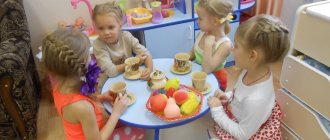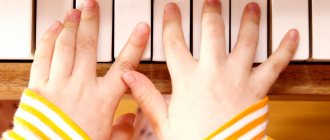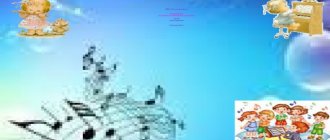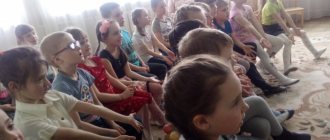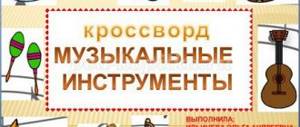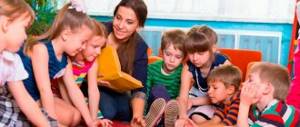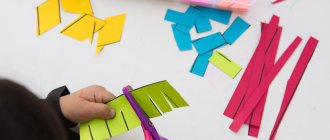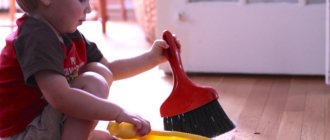The structure of a music lesson for children
Teaching a child music will be successful if the teacher has chosen the right approach to organizing music classes. In short, classes that use different types of activities and use play techniques are considered effective for preschoolers. With the correct structure of music classes, the systematic and comprehensive development of children is carried out, aimed at achieving their goals. At the same time, children are interested in fulfilling the teacher’s tasks; they are happy to get acquainted with new material, acquiring new and useful skills, abilities, and knowledge.
Types of music classes
Before starting music lessons with a child, the teacher must determine the type of this lesson, which will help select the further structure and sequence of work.
| Types of music classes | Characteristic |
| Individual work and work with subgroups | It is more often used in classes with younger preschoolers who find it difficult to work in large groups. The duration of such classes is 5-10 minutes, the frequency is 2 times a week. To make individual lessons more effective, different types of activities are combined, game techniques and bright visual attributes are used. Individual lessons may be needed not only for children who lag behind their peers: often such work is aimed at developing and improving specific musical abilities and learning to play musical instruments. Working with subgroups is appropriate when several children show interest in one musical activity. |
| Frontal exercises | They cover all types of musical activities and are carried out with children of the entire group. |
| Dominant activities | A dominant occupation is relevant for the development of a specific musical ability, and consists in the dominance of one of the types of musical activity:
|
| Thematic work | Thematic classes involve the use of all types of musical activities, united by a common theme. There are 3 types of such classes: actual thematic (can be held instead of a matinee), music-thematic, where the topic of the lesson is directly related to music (for example, “Dynamics”, “Timbre in music”, etc.), and plot-based, which is combined a single theme and has a common storyline. |
| Complex classes | They contain various types of art and artistic activities, are often frontal, and are carried out with a group of children. The purpose of complex classes is:
The recommended frequency of such classes is once a month. |
| Typical classes | As a rule, various types of musical activities are used in typical classes. In practice, it turns out that during classes one type of activity is not used, for example, playing musical instruments. If this phenomenon is inconsistent, then there are no violations in the organization of a typical lesson - this is the norm. |
Sheet music by numbers for piano for children
Sheet music and diagrams for xylophone
Children's developmental magazine JLiza.ru a lot of interesting information
Consultation “Musical lesson in the structure of musical education of children with disabilities
In music classes with children with phonetic-phonemic speech underdevelopment (FFSD), much attention is paid to the development of auditory and visual perception, as well as the improvement of motor skills.
Speech, music and movement in the classroom should be closely interconnected. Only in this case can the teacher achieve purity of intonation and expressiveness in children’s singing. In various types of movements accompanied by music, speech material is introduced in different ways.
1 Boromykova O. S. Correction of speech and movement. - St. Petersburg, 1999; Shashkina G.R. Speech therapy rhythm for preschoolers: In 3 hours - M., 2001. figurative forms: lyrics, round dances, dramatization with singing, staging.
When working on listening to music, speech material (prose and poetry) should be used, as it helps the child understand the content of a musical work. In the work of singing, several stages can be distinguished: the first stage is singing vowels, working on breathing, voice production, tempo and rhythm of speech; the second stage is the use of pure sayings with singing to reinforce whistling and hissing sounds; the third is the consolidation of sonorous sounds, the fourth is the consolidation of all sounds in free speech.
An important task of musical education of mentally retarded children, as noted by L.P. Noskova, O.V. Gavrilushkina and others, is the development of their auditory attention and emotional responsiveness to music. Carrying out systematic music lessons with children awakens their interest in music. They can react emotionally to the character of musical works and convey it through movement.
The musical education of mentally retarded preschoolers is closely related to the development of their ideas about the environment, therefore, when selecting a musical repertoire for classes, its programming, i.e., the display of a certain image, plot, is of great importance.
Preschoolers with mental retardation have underdevelopment of rhythmic hearing; they cannot coordinate their singing and their own movements with music. Therefore, in the first stages of training, the teacher acts together with the children, showing what should be done and how. Musical classes play a big role in the development of children's voice and speech. In the process of singing, speech acquires a certain rhythmic organization. Correction of deficiencies in the motor sphere also occurs: thanks to music, movements become more accurate and expressive.
An important stage in organizing musical classes is preparatory work: before listening to a piece of music, toys are played, an examination of the objects that are sung about in the song, or a conversation is held about the animals that are depicted in the music. Children are given a toy (bunny, bear, horse), asking them to play with it. Then the children, imitating the teacher, repeat characteristic movements after him, depicting a cat, bunny, bird, etc. Only after this the music director performs a piece of music, and the children, continuing to play, convey the image in movements to the music.
What requirements must a music lesson meet?
A good teacher, a professional in his field, when creating a musical lesson, must take into account the generally accepted requirements:
- The physical, mental and emotional stress of the child.
- The sequence of types of musical activities and repertoire used.
- The connection between the development of musical abilities, mastering skills and knowledge, and learning the musical repertoire.
- Age characteristics of students, presence and specifics of developmental disorders.
- Correspondence of activities to educational tasks of musical development.
To a greater extent, the effectiveness of music lessons depends on:
- educational material, its quality and content;
- set goals and objectives;
- characteristics of the child (age and individual);
- methods, teaching techniques;
- professionalism of the teacher and his ability to communicate with the child.
Structure of a standard music lesson
A standard lesson for the development of a child’s musical abilities includes 4 main areas:
- Listening to music.
- Rhythm.
- Hearing development.
- Development of music-making abilities.
With each new lesson, the material should become more complex and enriched with new information. However, do not forget about repeating the material already covered. Every musical lesson should contain novelty, surprise, an element of surprise. The teacher must carefully think through every second of the upcoming lesson and carefully prepare for its conduct. Improvisation is encouraged in music classes - it allows you to take a creative approach to solving problems, which is very useful for the development of a child’s cognitive processes.
In a musical lesson, different methods of musical activity should be used. In general, the structure of the lesson might look like this:
- Introductory part of the lesson: musical and rhythmic exercises. Task: to get the child ready to practice, develop dance skills, and learn simple dance moves.
- Main part of the lesson: a) Listening to music. Task: to cultivate in a child the ability to listen to the melody and accompaniment that create artistic and musical images, to teach him to react emotionally to the works he listens to. b) Singing and humming along. Objective: to develop the child’s singing skills, to promote the development of an ear for music, to teach to sing clearly without straining the voice, to correctly take and distribute breathing while singing. c) Musical and didactic games. The task is to introduce the child to musical instruments, their features and characteristics; develop the child’s cognitive processes and musical-sensory abilities.
- The final part of the lesson. Game or dance of your choice. Objective: to arouse in children interest in classes and a desire to study music; deliver emotional pleasure from the actions performed, evoke a feeling of joy.
Any musical lesson can and should be adjusted, adjusted to the necessary goals and objectives, taking into account the degree to which children have mastered the material being studied and their psycho-emotional state. And the main thing to remember is that a musical lesson should teach and develop the child’s abilities.
Summary of a dominant music lesson in the preparatory group of a kindergarten
Summary of the dominant music lesson “Let's go visit the Gnome, we'll find a miracle song!”
(preparatory group) Objectives: Educational: 1. Teach children to sing meaningfully and artistically expressively, purely intoning the melody. Developmental: 2. Continue to develop the mobility of the articulatory apparatus, expand the pitch range. Educational: 3. To instill in children an interest in singing. 4.Form moral qualities: a sense of empathy, a desire to help (Gnome). Vocabulary work: Activation of the dictionary: “staff”. Individual work: to activate inactive, shy children. Previous work: preliminary learning of the song “The Motley Cap” by G. Struve, the chants “Miracle Ladder”, “Ay”, the dance “Chick and Brik”. Material used: Didactic tools: stave on an easel, bead notes of different colors (7 pieces); Audio equipment: stereo system, disc with recorded music. Methodological techniques for the structure of the lesson: Motivation : the music director turns to the children with a request to help the Gnome collect bead notes (motive of personal interest).
Musical greeting "Hello, guests!" Communicative game “Greeting” by I. Kartushina Game with singing “Who said hello?” I. Kartushina Exercise “Ride, ride on a horse” Work on breathing. Exercises “Cold wind”, “Warming hands”, “Snowflake”, “Echo”. Vocal intonation exercises: “Ay”, “Miracle ladder”, “Snowdrifts”. Game with movement. “It’s frosty outside…” Vocal and intonation exercise “Blizzard.” Listening to the song “Tilly-bom” by E. Zaitseva Learning the song “Tilly-bom” by E. Zaitseva Performing the song “Motley Cap”, music. G. Struve Musical-ri T. Suvorova Course of the lesson:
Children enter the hall.
Musical greeting from the music director with the children: “Hello, guys.” Reciprocal musical greeting of children. Music leader: Guys, we have guests today, let’s welcome our guests too. Musical greeting “Hello, guests” to the music “Hello, hello, Dear guests! Hello, hello, You are welcome!” Music leader: Now, let’s say hello to each other to the music. Communication game "Greeting".
To the music, children walk freely around the hall, when the music ends, they stop and greet in different ways those who are nearby.
Repeated 3 times. Music leader: Guys, now we are going to play the musical game “Who said hello?” Game with singing “Who said hello?”
The driver stands in the center of the circle with his eyes closed.
One of the children sings: “Hello, Maria (driver’s name)!” The driver guesses from the child’s voice, approaches him and shakes his hand. The music director takes the envelope. Music leader: This morning I met the Postman, he gave you a letter from the Dwarf from the magical forest, (shows an envelope), do you want to know what he writes to us? (opens): “Dear friends, I’m in trouble! An angry blizzard flew into our forest, and my notes-beads scattered throughout the forest and now I can’t sing my favorite song. Guys, please help me collect the bead notes! Gnome” - Well, do you want to go into the forest and help the good Gnome collect his note-beads? Children: Yes! Music leader: What will we go on? Children: On a horse! Sledging! Exercise “Ride, ride on a horse”
We ride, ride on a horse (children click their tongues) On the smooth winter road (Click their tongues) The sleigh creaks (creak, creak, creak) The bells ring (ding, ding, ding) The woodpecker knocks (knock, knock , knock) The blizzard is whistling (whistle) We're riding, we're riding a horse (clicking their tongue) On a smooth winter road (clicking their tongue) Cold, cold, cold, cold (oooh) Fluffy snow is circling, circling (circling) We rode, we rode finally we arrived.
Whoa, here we come! Music leader: Oh, guys, look, here is the first bead note! (points to the note-bead that lies on the stump) We need to return the note to its place, on the staff. (The music director attaches the first note-bead) Where should the note be returned? Children: On the staff. Music leader: What’s the weather like in the forest? Are you cold? Children: Yes, it’s cold in the forest, it’s snowing. Music leader: Now I suggest you warm up. A little effort will improve your breathing. Breathing exercises.
Feel the cold on your palms.
Like a magician, the frost applied patterns to the windows. Exercise “Cold Wind”.
We'll warm up a little. Warm your palms.
Exercise “Warming your hands.” A breeze has appeared, We will blow on the snowball Exercise “Snowflake”.
Music
leader: Well, we’ve warmed up. Guys, I’ll tell you a secret, a magical echo lives in this forest. Let's listen to him. Exercise "Echo". Music leader : Echo, please tell us, have you seen the bead notes that the Gnome lost? Echo: Saw-lo-lo-lo! On the Christmas tree, Christmas tree, Christmas tree! Music leader : Look, what a beautiful Christmas tree, what’s on it? (children find the second note-bead on the Christmas tree and one of them attaches it to the staff). Music leader: Where do we place the bead note? Children: On the staff. Music leader: Well done, we found another bead note! Whose house do you think is visible in the distance? Children: Gnome's House! Music leader: We need to call the Gnome. Exercise "Aw!"
– achieve the sound of the head resonator on the sound “U”, repeat 3 times with an increase by a semitone.
Music leader: The Dwarf doesn’t appear, maybe he’s not at home? Let's look into the house, look - there is a ladder! I suggest you sing the “Miracle Little Ladder” song, maybe the Gnome will hear us! Exercise-singing “Miracle ladder”.
Music
manager: I noticed another bead on the roof? (attach the third note-bead) Where should it be attached? Children: On the staff. Music leader: The gnome is not at home, he is probably also looking for bead notes in the forest for his song. Let's follow in his footsteps. Look how much snow there is! Draws attention to the rope laid out in waves on the floor, snowflakes-points between the waves above and below. See what this drawing looks like? Children's answers. Music leader: It also seems to me that this drawing looks like snowdrifts. Snowdrifts often have bizarre shapes. Now I just want to sing the snowdrift song. Exercise "Sdrifts".
Singing along lines and dots to the sound “u” and “o” (“drifts” are laid out on the floor from rope) Music.
leader: Who wants to come up with their own song? Children change the movement of the rope and sing a “new song”. After the exercise, the fourth bead note is found. Game with the movement “It’s frosty in our yard.”
It’s frosty in our yard.
To keep your nose from freezing, you need to stomp your feet and clap your palms. (Children slap their hands on their shoulders and stomp their feet.) Now let’s imagine summer. The river is warmed by the sun. We swim, swim, swim, reaching the bottom with our feet. (Swimming movements with hands.) We leave the river and head to the edge. (Walking in place.) Music. leader: What is the name of a natural phenomenon when a strong wind blows and it snows? Children: blizzard, blizzard... Music. leader: Let's try to portray a blizzard. Exercise "Blizzard".
Singing in unison with a semitone increase.
Music leader: Guys, I want to introduce you to a new song? “Tilly-bom” by E. Zaitseva – listening.
Questions: •Who is this song about?
•What is the nature of the music (sad, melancholy, cheerful, kind, gentle, soulful) “Tilly-bom” by E. Zaitseva – learning. Techniques: •Singing by the music director. •The music director sings the verse, the children sing the chorus. Music leader: Guys, you sang so well! We have one more bead note (on the piano he finds the sixth bead note). The Gnome comes in to the music “Motley Cap”. He holds the seventh bead note in his hands. Gnome: Hello, guys! Did you get my letter? Children: Yes! We found six bead notes. Gnome: Thank you guys for helping me collect the bead notes and now I can sing you my funny song! The gnome sings the first verse of the song “The Motley Cap.” Dwarf: Do you want to sing together? Children, together with the Dwarf, perform the song “Motley Cap” Performing the song “Motley Cap”
Techniques: • Singing phrases in a “chain”.
•Quiet - loud. Dramatization of the song “Motley Cap” Dwarf: How fun it is to be with you that I even want to dance! Dance “Chick and Brick”
Gnome: Thank you again and goodbye! The children say goodbye to the guests and leave for the group.
We recommend watching:
Integrated GCD for music for kindergarten. Preparatory group Summary of educational activities on music for children of the preparatory group Music lesson in the senior group with TRIZ elements: Seasons Essay by the music director of the preschool educational institution
Similar articles:
Musical lesson in the senior group. Abstract
Musical-themed lesson on rhythm for the preparatory group of kindergarten
Music room scenario for children of senior and preparatory groups of preschool educational institutions
Scenario of musical leisure in the preparatory group of a preschool educational institution. Music by Shainsky
Musical festival in the preparatory group of kindergarten. Pushkin and music
